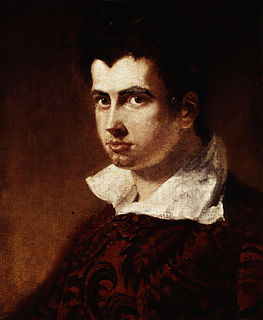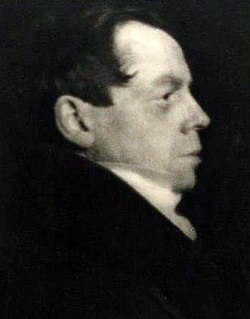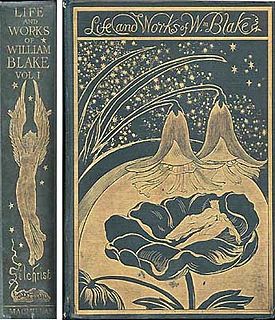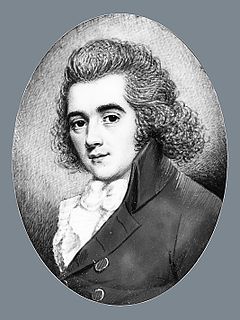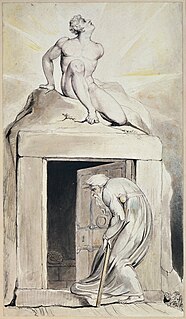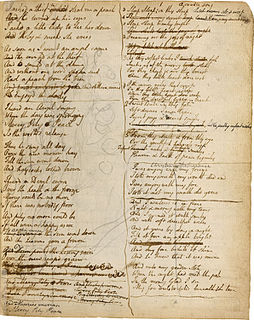Robert Hunt ( fl. 1809) was an English writer. His infamous reviews of the works of William Blake are amongst the earliest criticism of the poet and painter.
Floruit, abbreviated fl., Latin for "he/she flourished", denotes a date or period during which a person was known to have been alive or active. In English, the word may also be used as a noun indicating the time when someone "flourished".

William Blake was an English poet, painter, and printmaker. Largely unrecognised during his lifetime, Blake is now considered a seminal figure in the history of the poetry and visual arts of the Romantic Age. What he called his prophetic works were said by 20th-century critic Northrop Frye to form "what is in proportion to its merits the least read body of poetry in the English language". His visual artistry led 21st-century critic Jonathan Jones to proclaim him "far and away the greatest artist Britain has ever produced". In 2002, Blake was placed at number 38 in the BBC's poll of the 100 Greatest Britons. While he lived in London his entire life, except for three years spent in Felpham, he produced a diverse and symbolically rich œuvre, which embraced the imagination as "the body of God" or "human existence itself".
Robert was the brother of Leigh Hunt, the well-known writer, and John Hunt (1775–1848), who founded the Examiner ; his writing appeared in this influential journal.
John Hunt was an English printer, publisher, and occasional political writer. He was an elder brother of the poet and essayist Leigh Hunt and a brother of the critic Robert Hunt.
The Examiner was a weekly paper founded by Leigh and John Hunt in 1808. For the first fifty years it was a leading intellectual journal expounding radical principles, but from 1865 it repeatedly changed hands and political allegiance, resulting in a rapid decline in readership and loss of purpose.
His work might have remained in obscurity, if not for a vitriolic attack on the works and character of Blake during 1808 and 1809. [1] The second of these reviews was of Blake's exhibition at Golden Square in London, his illustrations to Chaucer's The Canterbury Tales and its Descriptive Catalogue . [2] Hunt's review of both these works was pungent, after the failure of the exhibition Blake's response was no less so, [3]

The Canterbury Tales is a collection of 24 stories that runs to over 17,000 lines written in Middle English by Geoffrey Chaucer between 1387 and 1400. In 1386, Chaucer became Controller of Customs and Justice of Peace and, in 1389, Clerk of the King's work. It was during these years that Chaucer began working on his most famous text, The Canterbury Tales. The tales are presented as part of a story-telling contest by a group of pilgrims as they travel together from London to Canterbury to visit the shrine of Saint Thomas Becket at Canterbury Cathedral. The prize for this contest is a free meal at the Tabard Inn at Southwark on their return.

The Descriptive Catalogue of 1809 is a description of, and prospectus for, an exhibition by William Blake of a number of his own illustrations for various topics, but most notably including a set of illustrations to Chaucer's Canterbury Tales, this last being a response to a collapsed contract with dealer Robert Cromek.
'The manner in which my character has been blasted these thirty years, both as an artist and as a man, may be seen particularly in a Sunday paper called the Examiner, published in Beaufort's Buildings; the manner in which I have rooted out the nest of villains will be seen in a poem concerning my three years' Herculean labours at Felpham, which I shall soon publish.'—Blake, W., Ms. (the "Rossetti Manuscript") [4]
Hunt's notice added emphasis to a selection of quotes from Blake's Descriptive Catalogue, as a preface "to amuse the reader, and satisfy him of the truth of the foregoing remarks." What follows is what Arthur Symons described as "among the infamies of journalism". [4] After a moralistic critique of 'insanity' permeating the arts, [1] he focuses on his example,
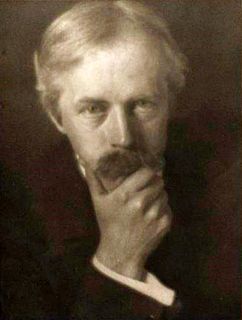
Arthur William Symons, was a British poet, critic and magazine editor.
"… But when the ebullitions of a distempered brain are mistaken for the sallies of genius by those whose works have exhibited the soundest thinking in art, the malady has indeed attained a pernicious height, and it becomes a duty to endeavour to arrest its progress. Such is the case with the productions and admirers of William Blake, an unfortunate lunatic, whose personal inoffensiveness secures him from confinement, and, consequently, of whom no public notice would have been taken, if he was not forced on the notice and animadversion of The Examiner, in having been held up to public admiration by many esteemed amateurs and professors as a genius in some respect original and legitimate. The praises which these gentlemen bestowed last year on this unfortunate man's illustrations to Blair's Grave have, in feeding his vanity, stimulated him to publish his madness more largely, and thus again exposed him, if not to the derision, at least to the pity of the public. ... Thus encouraged, the poor man fancies himself a great master, and has painted a few wretched pictures, some of which are unintelligible allegory, others an attempt at sober character by caricature representation, and the whole "blotted and blurred," and very badly drawn. These he calls an Exhibition, of which he has published a Catalogue, or rather a farrago of nonsense, unintelligibleness, and egregious vanity, the wild effusions of a distempered brain. One of the pictures represents Chaucer's Pilgrims, and is in every respect a striking contrast to the admirable picture of the same subject by Mr. Stothard, from which an exquisite print is forthcoming from the hand of Schiavonetti."—Hunt, R., The Examiner [4]
An earlier review in 1808 is given with his initials, "R.H.", two columns that contain the only notice published on the publication of Blake's illustrations to Blair's The Grave under the heading 'Fine Arts'. [5] It was here that the paper's wild and moralistic criticism, calling for censure of Blake's "libidinous" depictions and descriptions of his works as "absurdities". [4] Further remarks were added by R. H Leigh Hunt, then editor of the Examiner, listing Blake as a "quack". [6]
Robert Blair was a Scottish poet. His fame rests upon his poem The Grave, which, in a later printing was illustrated by William Blake.
Hunt's "extravagantly malicious attack" on these works was countered in Blake's notebooks, and, as some later critics contend, satirised in his poetry. Contemporary notices that followed echoed the sentiments expressed, but the partisan view of a coddled and talentless madman was submerged by biographical and critical notices that ranged from sympathetic to unconstrained adoration.
